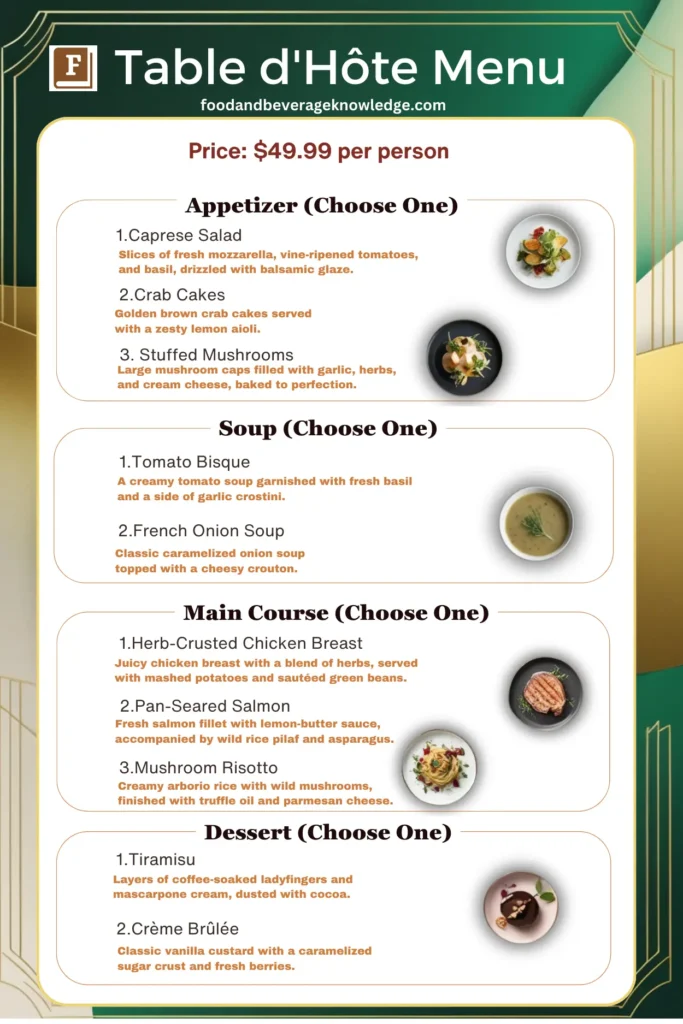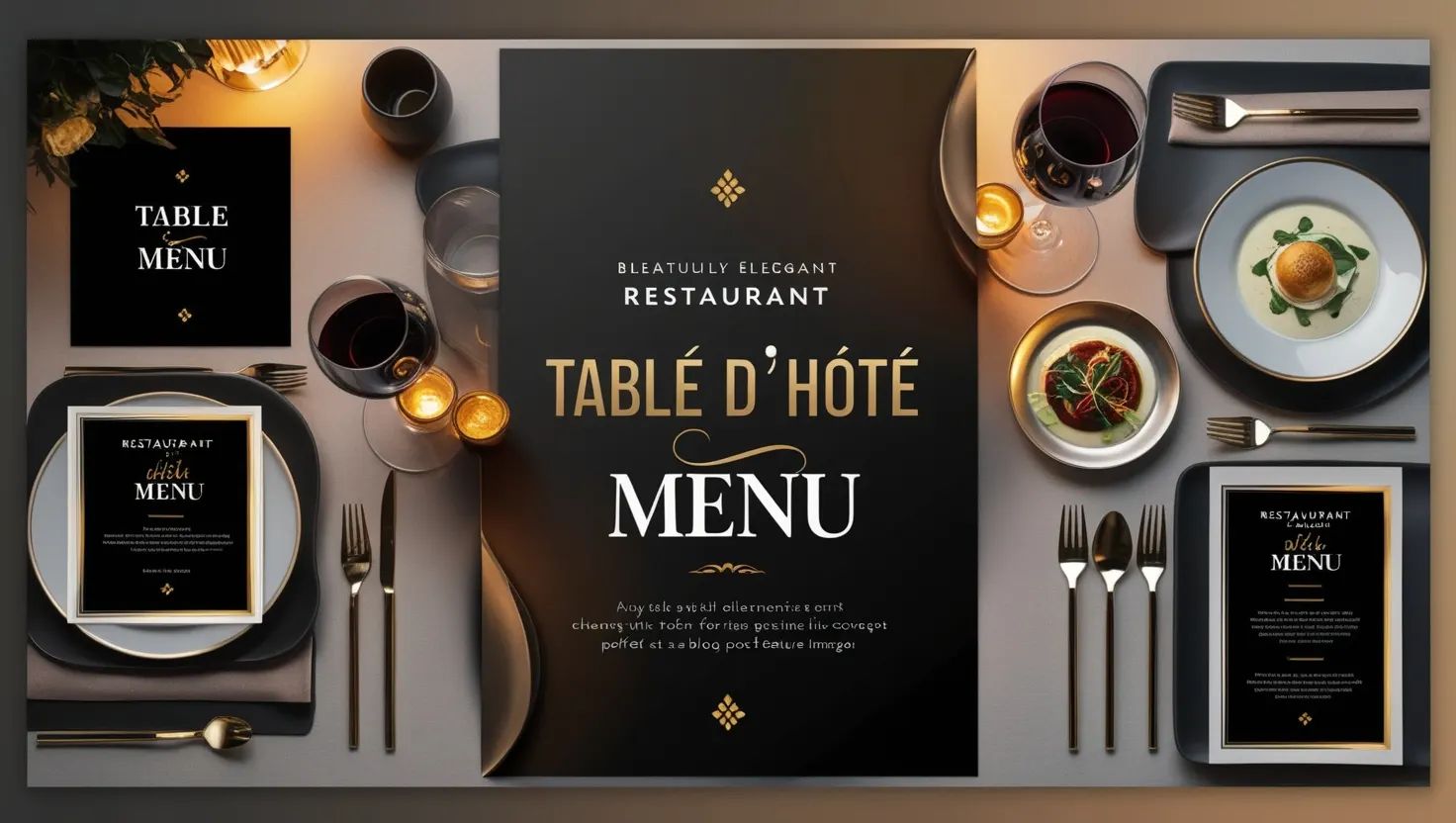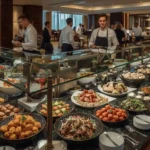The term Table d’Hôte originates from French, meaning “host’s table.” It refers to a menu format offering a fixed number of courses for a set price. Unlike the more flexible À La Carte menu, Table d’Hôte aligns closely with the principles of the French classical menu, offering a structured and cohesive dining experience.
This format is widely used in restaurants, banquets, and event catering due to its efficiency and appeal to diners seeking a well-rounded meal.
What is a Table d’Hôte Menu?
The Table d’Hôte Menu, often referred to as a fixed menu or set menu, features a prearranged selection of dishes offered at a set price. This type of menu is commonly used in restaurants worldwide and provides a curated dining experience. Its name, derived from French, translates to “host’s table,” reflecting its origins in communal dining.
How to Pronounce Table d’Hôte
The correct pronunciation is tah-bluh doht, with a soft “T” sound at the end. Mastering this pronunciation adds a touch of sophistication when discussing this elegant dining option.
Also read our guide on: A la carte menu, meaning, characteristics, advantage and disadvantage
History of Table d’Hôte Menu
The concept of Table d’Hôte originated in 17th-century France. It began as a practice in inns and guesthouses, where hosts would serve a communal meal to travelers at a shared table.
This approach was practical, ensuring efficient service and cost management. Over time, the concept evolved, and by the 19th century, it became a formalized dining style in restaurants, featuring pre-set menus with fixed pricing.
Key characteristics of a Table d’Hôte Menu:
- Fixed Price: Guests pay a predetermined price for the entire meal, regardless of the number of courses or choices provided.
- Preselected Courses: The menu is preplanned, offering a limited number of options for each course (e.g., starters, mains, and desserts).
- Balanced Meal Structure: The courses are designed to complement each other, providing a well-rounded dining experience.
- Efficient Service: Since the dishes are prearranged, the kitchen can prepare meals more quickly, reducing wait times for diners.
- Standardized Portions: The portions are consistent for all diners, ensuring uniformity in presentation and quantity.
- Limited Customization: Diners have restricted flexibility to make changes to the menu items or portions, which simplifies kitchen operations.
- Common in Formal Settings: This menu type is popular in banquets, weddings, and corporate events where efficient service and consistency are essential.
- Showcases Culinary Expertise: Often used in fine dining, the curated menu allows chefs to highlight their skills through seasonal or specialty dishes.
- Cost-Effective for Both Parties: It offers value to diners while enabling restaurants to reduce food waste and control operational costs.
- Traditional and Cultural Roots: Originating from France, the format has influenced various adaptations worldwide, such as the Indian thali, Spanish menú del día, and Japanese teishoku.
Sample of a Table d’Hôte Menu

For country-specific practices of table Table d’Hôte menu check on Wikipedia
Advantages and Disadvantages of Table d’Hôte Menu
Advantages
- Fixed Pricing: Provides cost predictability for diners and simplifies billing for restaurants.
- Efficient Service: Preselected dishes allow for quicker meal preparation and smoother service.
- Balanced Meal Design: Curated courses ensure a harmonious progression of flavours and textures.
- Reduced Food Waste: Limited options help control inventory and minimize waste.
- Culinary Showcase: Enables chefs to display creativity through cohesive, themed menus.
- Perfect for Large Events: Ideal for banquets, weddings, or conferences requiring uniform meals.
Disadvantages
- Limited Choices: Restricts diners who prefer more variety or customization.
- Dietary Challenges: These may not cater well to those with dietary restrictions or allergies.
- Perceived Rigidity: Fixed options may deter diners from seeking personalized meals.
- Portion Control Issues: Standardized portions may not suit everyone\u2019s appetite.
- Risk of Repetition: Lack of frequent menu updates can lead to monotony for regular customers.
- Reduced Upselling Opportunities: Fixed pricing limits additional revenue from premium add-ons or extras.
Related post: What is Menu Planning? Definition, Importance, and Best Practices
Differences Between Table d’Hôte and À la Carte Menus
Understanding the nuances between Table d’Hôte and À la Carte menus is essential for both hospitality professionals and diners. These two dining styles differ significantly in terms of structure, offerings, pricing, and customer
1. Definition
- Table d’Hôte: A French term meaning “Table of the Host,” it refers to a set menu with limited choices, where multiple courses are offered at a fixed price.
- À la Carte: Translates to “According to the Card,” it allows diners to choose individual dishes from an extensive menu, each priced separately.
2. Menu Structure
- Table d’Hôte: The menu is pre-designed, often featuring a few options per course (e.g., appetizer, main course, dessert). It’s streamlined and straightforward.
- À la Carte: Offers a wide variety of dishes categorized into sections like appetizers, mains, sides, and desserts. Diners can mix and match according to their preferences.
3. Flexibility
- Table d’Hôte: Limited flexibility, as diners must select from a fixed set of choices. Ideal for formal events or large groups.
- À la Carte: Highly flexible, allowing customization of meals to suit individual tastes and dietary requirements.
4. Pricing
- Table d’Hôte: The price is fixed for the entire menu, making it easier to budget. Often more cost-effective for multiple courses.
- À la Carte: Each dish is individually priced, which can lead to a higher overall cost depending on the diner’s selections.
5. Portion Sizes
- Table d’Hôte: Portion sizes are standardized for each course to maintain consistency and cost control.
- À la Carte: Portion sizes can vary, allowing diners to order small or large portions based on their appetite.
6. Customer Experience
- Table d’Hôte: Offers a curated dining experience, often designed to showcase a chef’s expertise or a specific theme.
- À la Carte: Provides a more personalized experience, catering to individual preferences and dietary restrictions.
7. Examples
- Table d’Hôte: A three-course lunch menu at a fixed price in a hotel or banquet setting.
- À la Carte: A restaurant menu where diners can order a Caesar salad, grilled salmon, and a cheesecake separately.
Examples of Table d’Hôte Menus
Example 1: Fine Dining Experience
Venue: Michelin-Starred Restaurant
Menu:
- Starter: Lobster bisque with truffle oil
- Main Course: Herb-crusted lamb rack with mashed potatoes and seasonal vegetables
- Dessert: Crème brûlée with a hint of lavender
- Price: $75 per person
Why it works: The curated selection highlights seasonal ingredients and showcases the chef’s expertise, delivering a cohesive dining experience.
Example 2: Casual Dining Special
Venue: Cozy Bistro
Menu:
- Starter: Caesar salad with homemade dressing
- Main Course: Grilled chicken breast with roasted vegetables and rice pilaf
- Dessert: Chocolate mousse
- Price: $25 per person
Why it works: Affordable pricing and balanced options attract customers during lunch hours or early dinners.
Example 3: Wedding Banquet
Setting: Formal Wedding Reception
Menu:
- Starter: Tomato and basil soup served with a bread roll
- Main Course (Option 1): Pan-seared salmon with dill sauce and asparagus
- Main Course (Option 2): Slow-roasted beef with red wine jus and creamy mashed potatoes
- Dessert: Vanilla cheesecake with berry compote
- Price: Included in the event package
Why it works: Offers variety while maintaining efficiency for serving a large number of guests.
Popular Uses of Table d’Hôte Menus
In Restaurants:
- Fine Dining: Seasonal and chef’s tasting menus often follow the Table d’Hôte format.
- Casual Dining: Lunch or early-bird specials attract diners with affordable set menus.
In Banquets:
- Weddings: Ensures a seamless dining experience for large groups.
- Corporate Events: Streamlines service during conferences and meetings.
In Hotels:
In-Room Dining: Often provides a simplified, fixed menu option for convenience.
12. Conclusion
The Table d’Hôte Menu is a timeless dining tradition that balances structure, efficiency, and culinary artistry. Whether experienced in a high-end restaurant, a cosy pub, or a cultural setting like India’s thali, it remains a popular choice for diners and restaurateurs alike. With its fixed pricing and prearranged courses, it offers a seamless journey through flavours, making every meal a memorable experience.
For offline reading, this post, save as a pdf
Related post:
- 17-Course French Classical Menu with Examples & Description
- A la carte menu, meaning, characteristics, advantages and disadvantage
- What is Menu Planning? Definition, Importance, and Best Practices
FAQs of Table d’hote menu
What is the meaning of Table d’Hôte menu?
A Table d’Hôte menu, meaning “host’s table” in French, refers to a dining format where a fixed selection of courses is offered at a set price. This type of menu provides a cohesive culinary experience and is common in restaurants, banquets, and catered events.
What is the difference between Table d’Hôte and À la Carte menus?
The key difference is flexibility and pricing:
Table d’Hôte offers a set menu with limited choices for a fixed price.
À la Carte allows diners to select individual dishes from a broader menu, each priced separately.
What are the advantages of a Table d’Hôte menu?
Some advantages include:
Predictable pricing for diners.
1. Efficient service and reduced wait times.
2. Balanced meal design curated by the chef.
3. Reduced food waste and better cost control for restaurants.
Subscribe and join our community of hospitality professionals & students — get insights, tips, and the latest updates delivered straight to your inbox!







